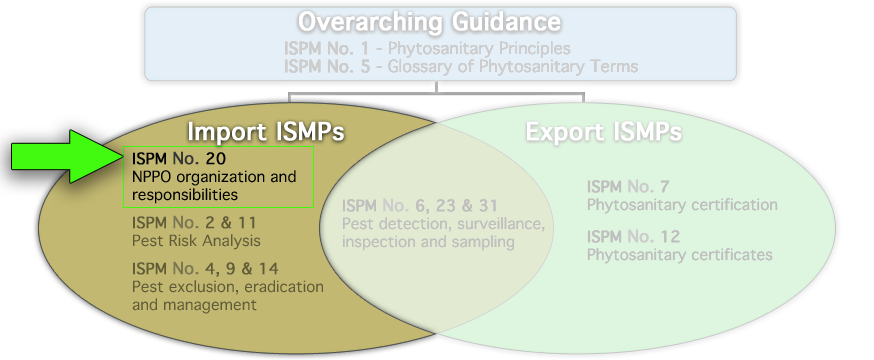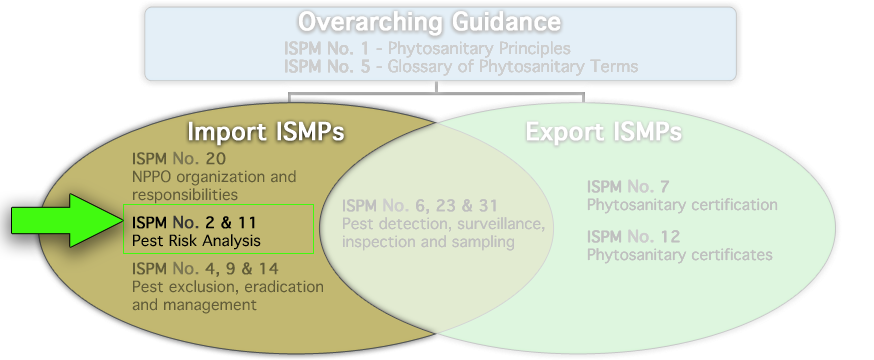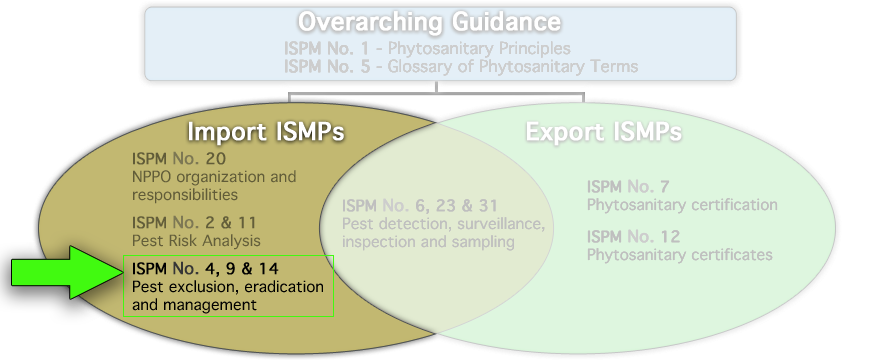Lesson 6: ISPMs and the NPPO
Topic 2: Import Systems and Operations
NPPOs carry out safeguarding operations to prevent pests from entering their countries on imported commodities. ISPMs provide guidance on the import-related authorities and responsibilities of an NPPO. ISPMs also provide guidance to NPPOs on how to carry out operations related to imports, such as assessing pest risk and excluding or eradicating pests.
Objectives:
- Import authorities and responsibilities of an NPPO:
- Describe the regulatory framework and operations of an import regulatory system (ISPM 20 and associated explanatory document)
- Pest Risk Assessment
- Discuss the role of pest-risk analysis in determining if a pest is a quarantine pest; i.e., pest categorization (ISPM 11)
- Identify the stages in a Pest Risk Analysis (PRA) (ISPM 2)
- Describe the steps in starting pest-risk assessment (ISPM 11)
- Pest Exclusion, Eradication, and Management
- Describe general requirements to establish pest-free areas (ISPM 4)
- Identify the activities in an eradication program and the factors to consider when undertaking an eradication program (ISPM 9)
- Discuss the characteristics of a systems approach and when it is appropriate to use a systems approach, (ISPM 14)
NPPO Organization and Responsibilities
The IPPC provides guidance for establishing a national plant-protection organization (NPPO) that fulfills certain responsibilities and that may vary in organization and structure, depending on the resources available, on the importance of agriculture to the country’s economy, and on the type of agricultural system in place.

ISPM 20: NPPO Organization and Responsibilities
Category:
Import Systems and Operations
Purpose of standard:
The purpose of ISPM 20 is to clearly and briefly cover the objectives of an import regulatory system and its structure, which includes a regulatory framework of phytosanitary legislation, regulations, and procedures, and of an official service, the NPPO, which is responsible for operation or oversight of the system.
Summary of standard:
ISPM 20 does not specify a particular legal system for an NPPO; however, it provides general guidelines to be considered when establishing a legal framework for an import system. Specifically, the framework should include legal authority for the NPPO to:
- Carry out its duties (for example, appoint officials; interact with other government bodies; inspect, test, treat, or detain consignments; and take samples)
- Regulate articles that might be infested or contaminated with a quarantine pest
- Regulate pests
- Impose phytosanitary measures to authorize imports
- Take emergency actions in the event of non-compliance
- Fulfill other obligations and responsibilities that are part of international agreements (for example, pest reporting, publishing regulatory information, and specifying points of entry)
ISPM 20 also identifies NPPO responsibilities in operating an import system. These include administering the import regulatory system, surveillance, pest risk assessment, auditing of plant health procedures in an exporting country, inspection, sampling, testing, taking action in case of non-compliance, spreading regulatory information, and settling disputes with other countries.
Pest Risk Analysis
PRA evaluates scientific evidence to determine whether an organism is a pest, the probability of its introduction and spread, the magnitude of potential economic consequences, and, when necessary, management options to reduce risk to an acceptable level. In conducting a PRA, IPPC obligations, including the minimal impact, non-discrimination, harmonization, transparency, and avoidance of undue delay, should be taken into account.

ISPM 2: Framework for Pest Risk Analysis
Category:
Import Systems and Operations
Purpose of the standard:
ISPM 2 describes the three stages of pest-risk analysis: initiation, pest-risk assessment, and pest-risk management
Summary of standard:
Stage 1:
Initiation involves four steps:
- Determining if an organism is a pest
- Defining the PRA area
- Evaluating previous PRAs
- Conclusion
Determining if an organism is a pest involves considering evidence such as previous history of successful establishment, belonging to taxa known to contain pests, and capability of acting as a host for known pests. The PRA area may be created for a whole country, for part of a country, or for several countries. Previously completed PRAs on the pest of concern or similar organisms should be reviewed. At the conclusion of stage 1, organisms that are candidates for further assessment are identified. Organisms that are determined not to be pests do not require further analysis.
Stage 2:
Pest-risk assessment involves the following steps:
- Pest categorization (whether a pest has characteristics of a quarantine pest)
- Assessment of introduction and spread
- Assessment of economic impacts
- Conclusion
The conclusion of stage 2 summarizes the overall pest risk and is used to decide if pest-risk management is required.
Stage 3:
Pest-risk management identifies measures (singly or in combination) that reduce risk to an acceptable level, that are available, and that are cost-effective and feasible.
ISPM 11: Pest-risk analysis for quarantine pests, including analysis of environmental risks and living modified organisms
Category:
Import Systems and Operations
Purpose of the standard:
The purpose of ISPM 11 is to provide detailed guidance on factors to consider in the pest-risk assessment and pest-risk management stages of pest-risk analysis. It also includes guidance on the evaluation of plants as pests (i.e., weeds) and on the potential phytosanitary risks posed by living modified organisms (LMOs), and includes information on the assessment of potential economic consequences and on risk communication.
Summary of the standard:
Information considered in the process of pest categorization includes:
- Identity of the pest
- Presence or absence of the pest in the geographical area the PRA covered
- Regulatory status of the pest
- Potential for establishment of the pest in the geographical area covered by the PRA
If an organism fulfills the criteria of quarantine pest, or if there is insufficient information, the PRA process should continue. If not, the PRA process can stop.
Assessment of economic impacts involves estimating the potential economic importance of the pest by considering direct negative effects of the pest on the potential host (i.e., yield losses, cost of control measures). Also considered are the indirect effects of the pest, that is, effects that are not host specific, including effects on domestic or export markets if the pest were to become established.
At the conclusion of the pest-risk assessment stage, there should be sufficient information to determine if pests require risk management.
Pest Exclusion, Eradication, and Management
Management of pests is fundamental to the safeguarding function of an NPPO. Exclusion and eradication are two strategies available to NPPOs to reduce the introduction and spread of a pest. Only three of the ISPMs related to an NPPO’s safeguarding mission are summarized here: ISPM 4, Requirements for the Establishment of Pest Free Areas, ISPM 14, The Use of Integrated Measures in a Systems Approach, and ISPM 9, Guidelines for Pest Eradication Programs. Other important standards related to specific treatments, commodities, and procedures are not discussed.

ISPM 4: Requirements for the Establishment of Pest-Free Areas
Category:
Import Systems and Operations
Purpose of the standard:
The purpose of ISPM 4 is to describe the requirements for establishing and maintaining a pest-free area.
Summary of standard:
The preferred strategy when dealing with pests in international trade is exclusion, i.e., prevention of the introduction of a pest. Requiring that exports come from a pest-free area (PFA) is one option an importing country can use to exclude pests.
The general requirements for a PFA are determining its boundaries, establishing it, and maintaining it. Pest freedom is established through general surveillance or specific surveys. PFAs are maintained through regulatory actions, such as pest listing, import requirements, movement restrictions, and routine monitoring. A pest-free area may refer to an entire country or to an uninfested part of a country.
ISPM 14: The Use of Integrated Measures in a Systems Approach
Category:
Import Systems and Operations
Purpose of the standard:
The purpose of this standard is to describe the concept of a systems approach and the circumstances under which it might be appropriate to use a systems approach.
Summary of the standard:
A systems approach combines different conditions or procedures to provide a similar alternative to a single measure, like a treatment or a restrictive measure, like prohibition. A systems approach is characterized by two or more measures that are independent of each other. An independent measure might be comprised of several dependent measures. Both independent measures must fail for the system to fail.
It is appropriate to use systems approaches when individual measures cannot meet phytosanitary import requirements, are not available, are harmful to the environment or the commodity, are not cost-effective, are unnecessarily trade-restrictive, or are not feasible.
Systems approaches provide the opportunity to consider the risk reduction that can be achieved by pre-harvest measures (e.g., fungicides applied in the field during the growing season, fruit bagging, growing in a greenhouse) and post-harvest measures (e.g., washing, brushing, dipping, waxing). In order to develop a systems approach, the pest and pest/host relationship must be well known. Additionally, the growing, harvesting, packing, and distribution practices must be well known and standardized.
ISPM 9: Guidelines for Pest Eradication Programs
Category:
Import Systems and Operations
Purpose of the standard:
This standard provides guidance for developing pest eradication programs, which, in most cases, apply to pests that have been recently introduced into an area.
Summary of the standard:
Some factors to consider when undertaking an eradication program are identified in ISPM 9. Countries should have contingency plans to address pests that have a high risk of introduction and pests for which eradication is needed. Eradication programs are started upon detection of the pest. Accurate pest identification and an estimate of the present distribution of the pest are critical to a successful eradication program. Country of origin and the pathway for entry or spread should be determined so that future pest entry can be prevented. An estimate of the impact and extent of infestation, of the potential for spread, and of the anticipated rate of spread is necessary to judge the feasibility of an eradication program.
The eradication process contains three main activities:
- Surveillance to fully investigate the spread of the pest
- Containment to prevent the spread of the pest
- Treatment to eradicate the pest when it is found
A survey to determine the boundaries should be completed, and monitoring surveys should continue to assess the effectiveness of the program. The NPPO should define a quarantine area to prevent the spread of the pest. Methods to eradicate pests may include one or more of the following:
- Host destruction
- Disinfestation
- Pesticide treatment
- Soil sterilants
- Cropping restrictions
- Trapping
- Lures or physical controls
- Use of sterile insect technique
Safeguarding functions of an NPPO are described in several standards: ISPM 20 describes import regulatory systems and responsibilities of an NPPO. ISPMs 2 and 11 describe pest-risk assessment. ISPM 4 describes pest-free areas, ISPM 14 describes systems approaches, and ISPM 9 provides guidelines for pest-eradication programs.
To continue, select Topic 3 from the Topics menu above or click here.